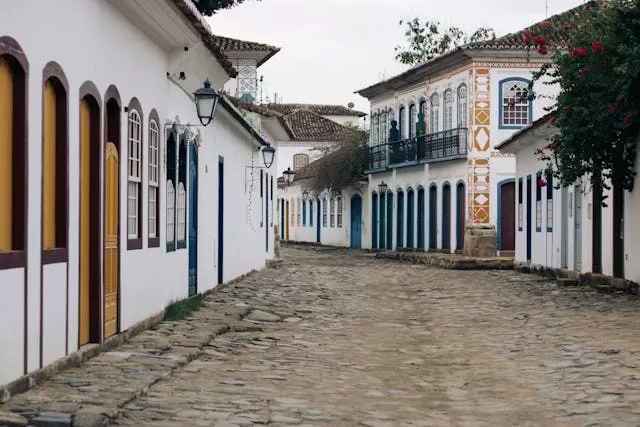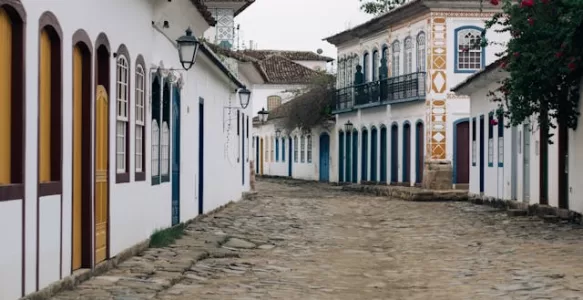Brazil is a vast and diverse country, renowned for its natural beauty, cultural richness, and vibrant history. It is home to numerous cities that reflect the country’s colonial past, African heritage, and indigenous traditions. These historic cities are not only culturally significant but also offer visitors a chance to step back in time, explore cobbled streets, visit historical landmarks, and discover the stories that shaped Brazil into the nation it is today. From the historic cities of Minas Gerais to the coastal charm of the Northeast, Brazil’s rich history can be seen in its architecture, cultural practices, and its people. In this article, we will explore ten of the most significant and captivating historic cities in Brazil that every traveler should visit.

1. Congonhas – Minas Gerais (MG)
Nestled in the mountains of Minas Gerais, Congonhas is one of Brazil’s most important historical cities, primarily known for its architectural and religious significance. The city is a UNESCO World Heritage Site and is home to the famous Sanctuary of Bom Jesus de Matosinhos, an important pilgrimage site.
Key Highlights
- Sanctuary of Bom Jesus de Matosinhos: The Sanctuary, a masterwork of Brazilian Baroque architecture, is famous for its 12 life-size sculptures created by the renowned artist Aleijadinho. These statues, known as the “Prophet Statues,” depict figures from the Old Testament and are a testament to Aleijadinho’s artistic genius. The Sanctuary is an iconic religious and historical landmark.
- Bom Jesus Church: The Church is another example of Brazilian Baroque architecture, with its ornate design and historical significance. Visitors can explore the church and its surroundings while gaining insight into the religious and cultural history of the region.
Activities and Accessibility
Congonhas can be easily accessed by road from Belo Horizonte, the capital of Minas Gerais. It offers a quiet and historical atmosphere perfect for those interested in religious history, colonial architecture, and local culture. The city provides a selection of charming pousadas (guesthouses) for travelers looking for a serene getaway.
2. Olinda – Pernambuco (PE)
Located in the state of Pernambuco in northeastern Brazil, Olinda is one of the most historically rich cities in the country. Known for its well-preserved colonial architecture, vibrant arts scene, and rich Afro-Brazilian culture, Olinda is a UNESCO World Heritage Site and one of the country’s most charming destinations.
Key Highlights
- Historic Center of Olinda: The city’s historic center is filled with colorful colonial-era buildings, cobblestone streets, and churches that date back to the 16th century. Olinda’s cultural heritage is reflected in its buildings, museums, and vibrant street art.
- Church of the Sé: The Church of the Sé is a beautiful example of baroque architecture and is one of the oldest churches in Brazil. It provides visitors with stunning views of the city and the Atlantic Ocean.
- Carnival in Olinda: Olinda’s Carnival is one of the most famous in Brazil, featuring parades, colorful costumes, and the unique “Bonecos Gigantes” (giant puppets). The city’s lively atmosphere during Carnival is a reflection of its Afro-Brazilian traditions and cultural diversity.
Activities and Accessibility
Olinda is easily accessible by bus or taxi from Recife, the capital of Pernambuco. It is an ideal destination for those looking to explore Brazil’s Afro-Brazilian culture, colonial history, and vibrant arts scene. The city offers various accommodations, ranging from boutique hotels to guesthouses, providing options for travelers of all budgets.
3. Ouro Preto – Minas Gerais (MG)
Perhaps the most famous historic city in Brazil, Ouro Preto is located in the state of Minas Gerais and is known for its well-preserved colonial architecture and rich mining history. The city is a UNESCO World Heritage Site and is considered one of the best examples of colonial urban planning in the country.
Key Highlights
- Historic Churches: Ouro Preto is home to some of Brazil’s most iconic baroque churches, including the Church of São Francisco de Assis and the Church of Nossa Senhora do Carmo. These churches, with their intricate designs and historical importance, provide a glimpse into Brazil’s colonial past.
- Museu da Inconfidência: This museum is housed in the former prison of Ouro Preto and is dedicated to the Inconfidência Mineira, a revolutionary movement that sought independence from Portuguese rule. The museum provides valuable insights into the region’s political and social history.
- The Mining Legacy: Ouro Preto is known for its mining history, which played a key role in Brazil’s economic development during the colonial period. Visitors can explore the city’s mining heritage through guided tours and visits to historical sites like the Mina de Ouro.
Activities and Accessibility
Ouro Preto is located about 100 kilometers from Belo Horizonte, the capital of Minas Gerais. The city is accessible by bus or car and offers a range of accommodation options. Ouro Preto’s rich history, colonial architecture, and cultural attractions make it an ideal destination for history lovers and those interested in Brazil’s past.
4. Paraty – Rio de Janeiro (RJ)
Paraty is a charming colonial town located on the Costa Verde (Green Coast) of Rio de Janeiro. Known for its picturesque streets, vibrant cultural scene, and rich colonial architecture, Paraty is a favorite among travelers seeking a mix of history, art, and natural beauty.
Key Highlights
- Historic Center: Paraty’s historic center is a maze of cobblestone streets, whitewashed colonial buildings, and colorful houses. The city’s well-preserved architecture offers visitors a chance to step back in time and experience Brazil’s colonial past.
- Church of Our Lady of the Rosary: One of the oldest and most significant churches in Paraty, the Church of Our Lady of the Rosary dates back to the 18th century and is an excellent example of colonial-era religious architecture.
- Cultural Festivals: Paraty is known for hosting several cultural festivals throughout the year, including the Paraty International Literary Festival (FLIP), one of Brazil’s most important literary events, attracting writers, artists, and intellectuals from around the world.
Activities and Accessibility
Paraty is easily accessible by bus or car from Rio de Janeiro and São Paulo. The town is an ideal destination for travelers seeking a combination of history, culture, and natural beauty. Paraty’s beautiful beaches and surrounding islands also make it a popular spot for water activities like boat tours, snorkeling, and kayaking.
5. Petrópolis – Rio de Janeiro (RJ)
Petrópolis, located in the mountains of Rio de Janeiro state, is a charming city known for its imperial history. It was once the summer retreat for Brazil’s royal family, and today, it offers visitors a glimpse into the country’s imperial past through its stunning architecture and historic sites.
Key Highlights
- Imperial Museum: The Imperial Museum is housed in the former summer palace of Emperor Pedro II and is one of Brazil’s most important historical museums. It showcases royal artifacts, including furniture, clothing, and personal items of the Brazilian monarchy.
- Crystal Palace: This beautiful glass-and-iron structure was built in the 19th century and was originally used for royal events and social gatherings. Today, it is a cultural venue hosting various exhibitions and events.
- Santos Dumont House Museum: This museum is dedicated to the life of Alberto Santos Dumont, one of Brazil’s most famous inventors and the pioneer of aviation. The house where he lived is now a museum, showcasing his life and contributions to flight.
Activities and Accessibility
Petrópolis is located about 68 kilometers from Rio de Janeiro and can be easily reached by bus or car. The city’s charming atmosphere, royal history, and surrounding mountain landscapes make it an ideal destination for travelers interested in Brazil’s imperial era and natural beauty.
6. Porto Seguro – Bahia (BA)
Porto Seguro is a historic city located in the state of Bahia and is one of the most important sites in Brazil’s colonial history. It was here that the Portuguese first landed in Brazil in 1500, marking the beginning of the country’s colonial era.
Key Highlights
- Historic Center: Porto Seguro’s historic center is a UNESCO World Heritage Site and features colonial-era buildings, churches, and museums that tell the story of Brazil’s early history.
- Discovery of Brazil Landmark: Porto Seguro is home to the landmark marking the site where the Portuguese first arrived in Brazil. Visitors can learn about the discovery of the country and its early colonial history at the Discovery of Brazil Memorial.
- Arraial d’Ajuda: This charming neighborhood in Porto Seguro offers beautiful beaches, colorful markets, and a laid-back atmosphere. It’s a great place to experience local culture, music, and cuisine.
Activities and Accessibility
Porto Seguro is easily accessible by air, with direct flights from several major cities in Brazil. The city is a popular destination for tourists looking to explore Brazil’s colonial history, cultural heritage, and beautiful beaches.
7. Salvador – Bahia (BA)
Salvador, the capital of Bahia, is one of Brazil’s most important historic cities, known for its Afro-Brazilian culture, colonial architecture, and vibrant music scene. The city was the first capital of Brazil and remains a cultural hub, offering a fascinating blend of history, art, and tradition.
Key Highlights
- Pelourinho: The historic center of Salvador, Pelourinho, is a UNESCO World Heritage Site known for its colorful colonial buildings, cobblestone streets, and historic churches. The area is also home to museums, galleries, and lively squares.
- Church of Bonfim: One of the most important religious sites in Salvador, the Church of Bonfim is a pilgrimage site for Afro-Brazilian devotees and is known for its beautiful architecture and cultural significance.
- Carnival in Salvador: Salvador’s Carnival is one of the largest and most vibrant in the world, with music, dancing, and street parties filling the streets. The city’s Carnival celebrations reflect its rich Afro-Brazilian culture and traditions.
Activities and Accessibility
Salvador is easily accessible by air and offers a wide range of accommodations, from luxury hotels to budget-friendly options. The city’s rich cultural scene, historic sites, and vibrant atmosphere make it a must-visit destination for travelers seeking to explore Brazil’s cultural heritage.
8. São Cristóvão – Sergipe (SE)
São Cristóvão is a small but historically significant town located in the state of Sergipe. Known for its well-preserved colonial architecture, the city is a UNESCO World Heritage Site and offers a glimpse into Brazil’s past.
Key Highlights
- Historic Center: São Cristóvão’s historic center features colonial-era churches, squares, and mansions that reflect the city’s rich history.
- Church of the Holy Cross: This 17th-century church is one of the oldest in Brazil and an important symbol of São Cristóvão’s religious and cultural heritage.
Activities and Accessibility
São Cristóvão is accessible by car from Aracaju, the capital of Sergipe. Its quaint atmosphere, colonial architecture, and historical significance make it a peaceful and fascinating destination for history enthusiasts.
9. São Luís – Maranhão (MA)
São Luís, the capital of Maranhão, is known for its well-preserved colonial architecture, Afro-Brazilian culture, and vibrant arts scene. The city’s historic center is a UNESCO World Heritage Site and reflects the influence of Portuguese, African, and indigenous cultures.
Key Highlights
- Historic Center of São Luís: São Luís’ historic center is filled with colonial buildings, cobblestone streets, and vibrant colorful houses. It offers visitors a chance to explore the city’s rich cultural and architectural heritage.
- Theatre Artur Azevedo: This historic theatre is one of the oldest in Brazil and is an important cultural venue for music, theatre, and dance performances.
Activities and Accessibility
São Luís is easily accessible by air from major cities in Brazil. The city’s vibrant arts scene, colonial architecture, and Afro-Brazilian culture make it a unique destination for travelers seeking history and culture.
10. Tiradentes – Minas Gerais (MG)
Tiradentes is a charming historic town in the state of Minas Gerais, known for its preserved colonial architecture, cobblestone streets, and historical significance.
Key Highlights
- Historic Center: Tiradentes is known for its well-preserved colonial architecture, including churches, mansions, and public squares. The city offers a serene atmosphere and a step back in time to Brazil’s colonial past.
- Church of Santo Antônio: This 18th-century church is one of the most important historical landmarks in the city, with its stunning baroque architecture and historical significance.
Activities and Accessibility
Tiradentes is easily accessible from Ouro Preto and other cities in Minas Gerais. Its charming atmosphere and colonial architecture make it a must-visit destination for history lovers. The city also offers a selection of boutique hotels and guesthouses for a comfortable stay.
Brazil’s historic cities are an essential part of the country’s identity, offering a window into its colonial past, cultural evolution, and unique blend of traditions. From the baroque churches of Ouro Preto to the colorful streets of Salvador and the peaceful cobblestone lanes of Tiradentes, these cities showcase Brazil’s rich history and vibrant culture. Whether you are an art lover, history enthusiast, or simply seeking an unforgettable travel experience, these historic cities are a must-visit for any traveler to Brazil.


